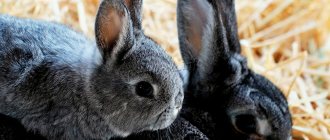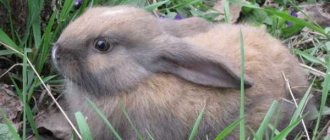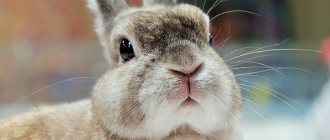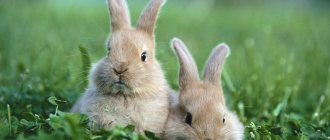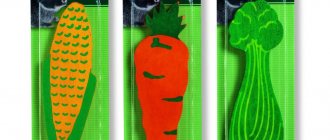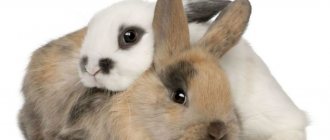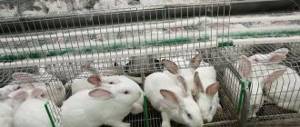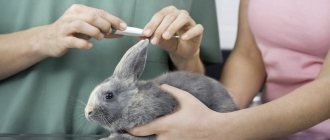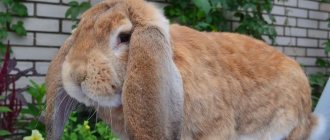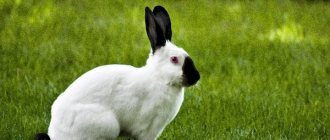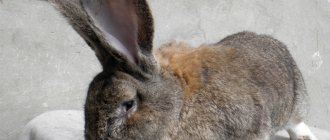The Stroka rabbit is a beautiful large animal with a stocky, elongated body and a unique spotted coloring. It is endowed with an active and nervous temperament, and received its name because of the contrasting stripe on the back in the form of an even sewing line.
The animal attracts attention at first sight and rarely goes without prizes at exhibitions. True, breeding the breed is fraught with certain difficulties and can only be done by experienced breeders who know what nuances are hidden behind the spectacular appearance of these rabbits and how to care for them.
History of the origin of the breed
Stroka rabbits were bred as a result of long-term targeted selection, which began in the first half of the 18th century. To obtain them, representatives of several large-sized breeds were used at once, among which were Belgian Flanders and English spotted rabbits.
Due to long-term selection, specialists managed to improve the productive qualities of these animals and achieve their recognition. The official registration of the new German breed took place in 1908.
Interesting! Because of the characteristic dark spot on the rabbit's face, the strokach rabbit is often called the German "butterfly".
History of origin
The breed has many names, the most common of which are German motley giant, German butterfly, “Strokach”. Rabbits received their last name for their characteristic “line” - a black stripe that runs along the back and distinguishes them from other colorful representatives of this category of animals.
A distinctive feature of the stitchers is the black stripe (“stitch”) running along the entire back along the ridge
The exact history of the origin of this breed is unknown, since work on its breeding was carried out at the beginning of the 18th century. The appearance of streakers was the result of crossing several varieties common at that time - Belgian giants (Flanders), English spotted and others. Their strengths were their large size, the taste of meat and high fertility. Thanks to long-term selection, it was possible to obtain highly productive animals that combine the best qualities of numerous ancestors. Strokers were recognized as a separate breed in 1907 after an exhibition in Germany, where this type of rabbit was highly praised by experts.
You can learn a little more about German motley giants from the following video:
Breed standard
Strokach is a beautiful large-sized rabbit with a proportionally built body and light bones. A full description of the breed is given in the official standard, which has not changed since the recognition of the species.
Constitution
A typical Strokach rabbit should look like this:
- The head is of medium size. In females it has a more elongated shape, in males it is rounded.
- The eyes are large and dark.
- The ears are straight, covered with soft fur. The length of the ear membrane is 16-18 cm.
- The body is dense, stocky, with well-developed muscles, a short neck, a long arched back, a broad chest and a small tail sticking up. The female strokacha has a small dewlap.
- The limbs are smooth, powerful, with strong, colorless claws.
Color, weight and dimensions
Strokach is a large rabbit. Its body length is on average 70 cm, and its weight varies between 5-10 kg. Although among the representatives of the breed there are also heavier individuals weighing 11-11.5 kg.
Interesting! Due to its impressive dimensions, the Stroke rabbit received the nickname “German giant”.
Representatives of this breed have soft, short fur and a characteristic pattern on the body. On the main white background of the coat of German giants there are black, dark gray or blue markings.
The area around the eyes and ears of rabbit rabbits is completely dark, and along their spine there is a wide stripe, on the sides of which spots of indeterminate shape are randomly located.
On the face of the representatives of the breed there is a symmetrical print in the form of butterfly wings. It completely covers the rabbits' nose and rises to the middle of the bridge of the nose, forming a rounded protrusion.
Productivity and Fertility
This breed of rabbit is bred for its juicy meat with excellent taste. Animals grow very quickly and reach their maximum weight by 8 months. German giants have a strong but light frame. Thanks to this, 55-60% of meat can be obtained from 1 carcass of a strokach.
German giants are early maturing and fertile breeds. Rabbits become sexually mature at 4 months and are capable of producing 7-10 babies.
Permissible and unacceptable deviations
Even purebred rabbits can have defects in appearance. The permissible deviations, the presence of which does not cast doubt on the origin of the line, include:
- pigmented claws;
- zigzag edges of the spot on the nose;
- dark speckles on top of head;
- unclear outlines of marks on the sides;
- slight errors in coloring.
Inadmissible deviations that call into question the purebred of the Stroka rabbit include:
- bald spots and tufts on a fur coat;
- no spots on the cheeks;
- non-butterfly shaped markings on nose;
- weak or absent pattern on the face and back.
Purebred rabbit and its signs
A stroka rabbit, if bred in accordance with the standards, has certain characteristics by which it can be distinguished from other breeds. A purebred animal will have a regular geometric pattern on its coat with smooth edges. There may be inclusions of black or brown.
There are no bald patches or tufts on the fur. The weight of an adult is 6-10 kilograms. The main color of the rabbit will be white with black or brown splashes.
Important! If the animal is aggressive, then this indicates that it is not purebred.
Females are distinguished by a developed maternal instinct and a large amount of milk when feeding. Baby rabbits will usually all be the same color after birth. Over time, a pattern will appear on their fur.
See also Flanders rabbits
Care and maintenance
German giants are unpretentious animals, so they do not need special conditions. In the room where representatives of the breed are kept, the temperature should be 16-25 °C and humidity 60-70%.
It is recommended to house the Strokacha rabbit in a spacious cage with a solid or slatted floor with a bedding of hay or straw. It is advisable to place the German giant’s home in well-lit places, away from drafts and direct sunlight.
The optimal cage size is 0.8 × 1 m, and the height is 0.5 m. A drinking bowl must be attached inside and a heavy ceramic feeder must be installed.
On a note. During the summer months, rabbits enjoy being outside. To prevent them from escaping, they are released into a fenced pen free of rocks and debris.
In general, caring for rabbits comes down to maintaining the cleanliness of the rabbit’s home. The cage is cleaned every 2-3 days, and once a week it is burned with a blowtorch or treated with disinfectants.
Keeping the German breed of rabbits
The rules for caring for this giant will be slightly different from the traditional ones. First of all, it is necessary to provide sufficient space, so the cage must be spacious. For a female with a brood, it is necessary to leave a territory up to 185 centimeters long and about a meter wide.
The height of a standard cage for rabbits should also be increased taking into account the size of these giants (approximately 70 - 80 centimeters). A single cage for adults should be approximately 100x100 centimeters, the height remains the same.
The Strokach breed, unlike the New Zealand breed of rabbits, cannot be called easy to breed, so it is not recommended for beginners to have these animals. Rabbits have an inquisitive and restless disposition, so it is necessary to think through the tactics of caring for them. The main thing is to make it clear in time who is the master of the situation, then these animals will willingly recognize the leadership of the owner.
The video shows how the correct content occurs:
Basic content rules:
- Protection from drafts and dampness.
- The place must be dark, but lighting plays an important role in the development of animals.
- There must be constant access to fresh and clean water.
- Every six months, preventive vaccinations against common diseases are given. A comprehensive vaccination against myxomatosis and VHD (viral hemorrhagic disease of rabbits) has proven itself best.
- For summer maintenance, it is advisable to consider a stationary or portable pen for walking.
- It is necessary to change the bedding and remove leftover food daily.
For the convenience of breeding Soviet Chinchilla rabbits, as for other breeds, it is recommended to make cages yourself. This way you will not only save money, but also be able to make optimal use of the rabbitry space. To do this, you need to stock up on wooden materials, as well as a metal mesh to provide the rabbits with the necessary ventilation. Schemes and a detailed algorithm of work can be found on thematic video lessons on the Internet, so this will not be difficult.
Features of feeding
The Stroke rabbit eats little by little, but often. Therefore, the owners will have to ensure that there is always fresh food in the German giant’s bowl. The animal’s diet must include:
- grains (corn, barley, wheat and oats);
- fresh grass;
- tree branches and bark;
- feed;
- vegetables;
- fruits.
Dairy products, green potatoes, meat, cabbage, plants with a high concentration of essential oils, sweets, almonds, nutmeg and stale food are completely excluded from the diet of German giants.
Rabbit breeding
To maintain a stable genotype and produce rabbits with the correct color, purebred, completely healthy representatives of the breed without defects in appearance are allowed for breeding.
German giants begin to be flogged no earlier than they are six months old. In order for the crossing to be successful, the female is put into the male’s cage and left there for some time.
Pregnancy in a strokach lasts 25-34 days and ends with the birth of 7-10 babies. On the tenth day, the baby rabbits open their eyes and become similar to adults. Up to 1.5 months they feed on their mother’s milk. Rabbits can be moved into a separate cage 2 weeks after the lactation period ends.
On a note. Newborn babies often have monochromatic fur. German giants acquire their characteristic spotted coloration as they grow older.
Breeding
The peculiarity of breeding German Strocha rabbits is that they reach sexual maturity at an early age. A rabbit from the Strokach breed is capable of creating offspring as early as 6 months, but they usually begin to do this at eight. One rabbit litter can contain up to 10 babies. Typically, breeding rabbits does not require any participation from the animal owners.
After giving birth, the female provides her rabbits with a sufficient amount of milk and never refuses them. The feeding process is long compared to other breeds. That is why it is impossible to do without losses.
See also Features of breeding Lionhead rabbits
How to choose a rabbit
It is recommended to buy a baby rabbit from a trusted breeder who can document the origin of the animal. When choosing a little German giant you should pay attention to:
- for the presence of a pedigree and veterinary passport;
- compliance with the breed standard;
- health status;
- behavioral features.
On a note. A rabbit that is too small and has unevenly growing or incorrectly colored fur may turn out to be a mixed breed. Therefore, you should refrain from buying it.
Strokach is a large, cute rabbit with a uniquely colored soft, glossy coat. The German giant is unpretentious in keeping, but quite difficult to breed. Therefore, the breeding of representatives of the breed should be carried out by professionals.
